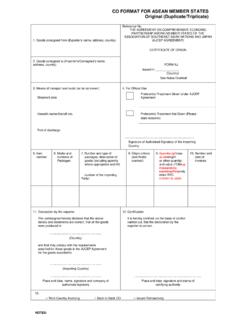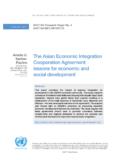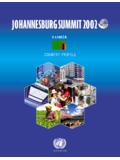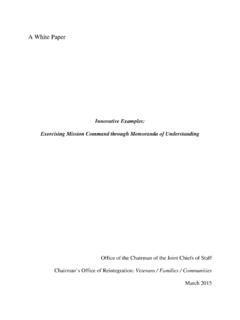Transcription of Trade Economic Engagement 2112015 - hcicolombo.org
1 1 INDIA-SRI LANKA Economic AND Trade Engagement OVERVIEW India is Sri Lanka's closest neighbour. The relationship between the two countries is more than 2,500 years old and both sides have built upon a legacy of intellectual, cultural, religious and linguistic intercourse. Relations between the two countries have also matured and diversified with the passage of time, encompassing all areas of contemporary relevance. The shared cultural and civilization heritage of the two countries and the extensive people to people interaction of their citizens provide the foundation to build a multi-faceted partnership. In recent years, the relationship has been marked by close contacts at the highest political level, growing Trade and investment, cooperation in the fields of development, education, culture and defence, as well as a broad understanding on major issues of international interest.
2 India and Sri Lanka enjoy a vibrant and growing Economic and commercial partnership, with bilateral Trade growing rapidly in the last decade and a number of leading Indian private sector companies investing in Sri Lanka and establishing a presence in this country. Sri Lanka is India's largest Trade partner in SAARC. India in turn is Sri Lanka's largest Trade partner globally. Much of the impetus for the current level of our Economic interaction stemmed from the signing and entry into force of the Free Trade Agreement (FTA) in 1998 and 2000 respectively. During January-August 2015, the bilateral Trade amounted to US$ billion. Sri Lanka s imports from India amounted US$ 2, million and exports to India amounted US$ million. During the year 2014, Sri Lanka continued to be one of the largest trading partners of India in South Asia. According to Sri Lankan Customs Trade data the bilateral Trade amounted to US$ billion in 2014.
3 Sri Lanka s imports from India amounted US$ 3, million and exports to India amounted US$ million registering an increase of and respectively as compared to corresponding period of 2013. India had a share of and respectively in the global imports and exports of Sri Lanka during 2014. It may be noted that in 2014 Sri Lanka s exports to India has reached a new peak of US$ million which is the highest since the introduction of ISLFTA in 2000. While Sri Lankan exports to India have increased substantially during past 12 years since 2000 when ISFTA came into force, they have lagged behind the high growth in India s exports to Sri Lanka, resulting in a widening of the balance of Trade . This is largely because of the lack of export capacity from Sri Lanka to service Indian requirement and also due to increase in imports from India because of competiveness of our exports.
4 Interestingly, over 80% of our exports to Sri Lanka are outside the list of products covered by the FTA, thereby indicating their overall competitiveness in the Sri Lankan market. During January-June 2015, Indian Investment amounted to US$ million out of total investments of US$ million in the country. In 2014, Indian Investment amounted to US$ million out of total investments of US$ 1616 million in the country. India emerged as the eighth largest overall investor in Sri Lanka with investments of US$ million in 2013. The main investments from India are in the areas of petroleum retail, hospitals, telecom, real estate, telecommunication, hospitality & tourism, banking and financial services, IT and food processing (tea & fruit juices). The notable Indian investments committed in 2014 are as follows: i) ITC Ltd., hotel project (US$ 300 million) and ii) Tata Housing project for real estate development (US$ 400 million).
5 On the other hand, the last few years have also witnessed an increasing trend of Sri Lankan investments into India. Significant examples include Brandix (about US$ 1 billion to set up a garment 2 city in Vishakapatnam), MAS holdings, John Keells, Hayleys, Aitken Spence (Hotels), Ceylon Biscuits (Munchee brand) and Carsons Cumberbatch (Carlsberg), apart from other investments in the freight servicing and logistics sector. After the end of armed conflict in 2009, substantial opportunities for reconstruction, infrastructure development and revival of local economy emerged. India announced a package of Rs. 500 crores as grant for rehabilitation/reconstruction activities, apart from assistance for construction of 50,000 houses for IDPs in Northern and Eastern Sri Lanka. Several large infrastructure projects supported by Lines of Credit (LOC) amounting to over US$ 1 billion are being funded by Government of India for restoration of arterial railway lines connecting the north and south of Sri Lanka, wreck removal, dredging and port revival at Kankesanthurai (KKS) and the development of a civilian airport at Palaly.
6 NTPC has incorporated a Joint Venture in partnership with Ceylon Electricity Board (CEB), for construction of a 500 MW coal-based power plant in Sampur, located south of the Trincomalee harbour. Government of India has pledged a separate Line of Credit of US$ 200 million to enable construction of key infrastructural facilities associated with this project. There has been resistance from some section of the Sri Lankan businessmen for concluding Comprehensive Economic Partnership Agreement (CEPA) with India. There has been no progress for finalization of the document since January 2011. In tourism India continued to be the largest source of tourists coming to Sri Lanka. The total number of tourist arrivals from India to Sri Lanka during January-September 2015 was 220,907 approximately of the total tourist arrival into Sri Lanka. In 2014, out of the total 1,527,153 tourists, 242,734 were from India and showing an increase of compared to 2013.
7 Sri Lankan tourists too are among the top ten sources for the Indian tourism market. In 2014, more than one lakh ninety five thousand visas were issued by the High Commission in Colombo to facilitate travel between India and Sri Lanka. BILATERAL AGREEMENTS The juridical framework for the relationship is provided by a Free Trade Agreement, a Double Taxation Avoidance Agreement, a Bilateral Investment Protection and Promotion Agreement. Bilateral agreements/MoUs on Air Services, Small Development Projects, Cooperation in Small Scale Industries and Cooperation in Tourism and an Agreement on Cooperation in Science and Technology also exist. A Comprehensive Economic Partnership Agreement (CEPA) is under negotiation. India-Sri Lanka Free Trade Agreement (ISFTA) The main framework for bilateral Trade has been provided by the India-Sri Lanka Free Trade Agreement (ISFTA) that was signed in 1998 and entered into force in March 2000.
8 The basic premise in signing the ISFTA was asymmetries between the two economies, local socio- Economic sensitivities, safeguard measures to protect domestic interests, and revenue implications so as not to impact high revenue generating tariff lines in the short term. In a nutshell, India sought to do more without insisting on strict reciprocity from Sri Lanka. This is reflected in the respective obligations of the two countries under the ISFTA where India agreed to open more tariff lines upfront and within a shorter time span of three years as against smaller and more staggered openings by Sri Lanka which was provided a longer time of eight years. As a result of ISFTA, currently 4150 Indian tariff lines have been made zero duty for Sri Lankan exports to India. Similarly, 3932 tariff lines have been made zero duty for Indian exports to Sri Lanka.
9 In addition to these steps, India has offered quotas to Sri Lanka on certain tariff lines (a) 15 million tonnes of Tea (5 tariff lines) with 50% margin of preference with no port entry restrictions since June 2007; (b) Textiles, where there is a 25% tariff reduction for 528 Textile items; and (c) Garments where 3 the 50% margin of preference on 8 million pieces over 233 tariff lines. The Garments quota terms have been further liberalized through a MoU on October 5, 2007 by which the Government of India has issued a Custom Notification No. 52/2008 dated 22 April 2008 giving immediate effect to the MoU. As a result, India has reduced duty to zero and removed restrictions on entry ports and sourcing of fabrics from India for 3 million pieces of apparel products from Sri Lanka. India has also removed port restrictions on the balance 5 million pieces of apparel products.
10 These 5 million pieces of garments will be allowed to enter India at zero duty or Margin of Preference of 75% depending on the product category provided that they are manufactured using Indian made fabrics. India has recently decided to do away with the condition of Indian made fabrics and a formal notification is expected soon. As of now, 1180 tariff lines remain in the Sri Lankan negative list that includes Agriculture/livestock items, rubber products, paper products, Iron and Steel, machinery, and electrical items. On the Indian side, there are 429 items in the negative list, which include garments, plastic products and rubber products etc. ISFTA Rules of Origin In order to receive ISFTA benefits, the merchandise exported between India and Sri Lanka should comply with the following Rules of Origin criteria.









